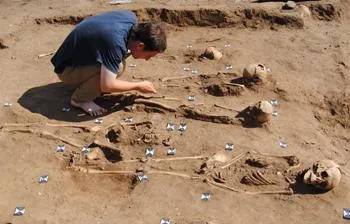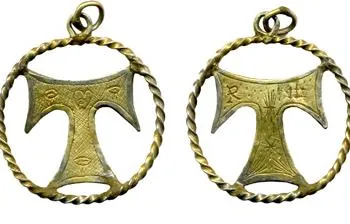English Mass Grave Sheds New Light on the Horrors of the Black Death
The burial pit contained 48 skeletons that tested positive for the plague
The Black Death is among the most traumatic epidemics in recorded history. The disease swept through 14th century Europe, killing hundreds of millions of people. Now, a newly-discovered burial pit at the site of a former abbey in the English countryside could shed new light on how people outside of major cities were devastated by the plague, Haroon Siddique reports for The Guardian.
Historians estimate that nearly half of England’s population was killed by the plague in the mid-14th century, but until now the only cemeteries that researchers knew of with evidence of the Black Death were found inside London. But recently, archaeologists working at the ruins of a medieval abbey in the countryside north of the capital came across a mass grave dating back to 1349, a year after the plague first hit England, writes Siddique.
"The finding of a previously unknown and completely unexpected mass burial dating to this period in a quiet corner of rural Lincolnshire is thus far unique, and sheds light into the real difficulties faced by a small community ill-prepared to face such a devastating threat," Hugh Willmott, a researcher at the University of Sheffield's Department of Archaeology, says in a statement.
The grave contained 48 skeletons, 27 of which were children. After the archaeologists uncovered it, they were able to recover tooth samples from some of the remains, which were then sent off to McMaster University in Canada for DNA analysis. The scans found traces of DNA left from Yersinia pestis, the bacterium responsible for the plague, suggesting that these bodies fell victim to the black death, the BBC reports.

The origins of the pit may be gruesome, but finding a mass burial like this is rare in England. Most people at the time were buried in graves in their local parish, as communities tried to maintain some semblance of normal rites despite the high death rates, Oliver Moody reports for The Times. Even though these bodies were buried all together, they were still found laid out in even rows, suggesting that the mourners still took care with the bodies of the deceased.
“You only get graves like this when the normal system of burial has broken down,” Willmott tells Moody. “Whether the priest [was] dead or the gravediggers had died, we don’t know. This clearly was a community that was hit very hard and had to rely on the monastery for help.”
In addition to the human remains, Willmott and his colleagues uncovered little trinkets and remnants of the things these people may have carried while alive. One intriguing find was a small amulet in the shape of a T, which people at the time may have believed could cure certain diseases, Moody reports.
As the excavation continues, Willmott and his team hope that they can uncover more details about these people’s lives from objects from the mass grave and more genetic clues gathered from the remains. With more insight into how these people lived, historians can finally start to figure out how people in the countryside managed the devastating disease.


